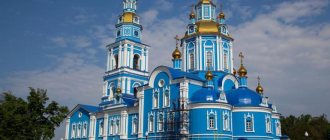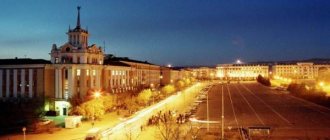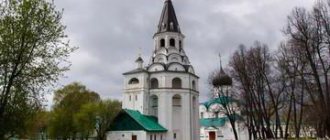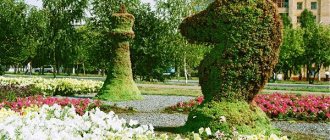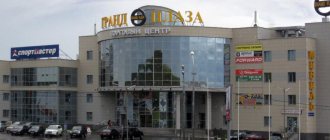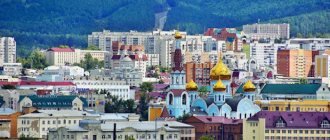Amazing natural sites, interesting museums, majestic temples - all these attractions of the Irkutsk region attract the attention of tourists. The city was formed back in 1661 on the banks of the Siberian Angara River, and since then it has flourished and developed. Even the squares and streets look so beautiful that they can compete with the capital of Russia.
1. 130th quarter
The 130th quarter, or Irkutskaya Sloboda, is a unique historical landmark in the very center of Irkutsk, known for its colorful wooden buildings. The Irkutsk settlement began to be built up back in the 18th century, and at that time the basis of its architectural ensemble was made up of log peasant houses and rich merchant estates. Several years ago, for the city's anniversary, the historical buildings of the Irkutsk settlement were restored, and now the 130th quarter boasts many original old mansions with elegant window frames and elegant decorative carvings. The historical atmosphere of the Irkutsk settlement is perfectly complemented by the most interesting museums located on its territory: the Museum of the Siberian Railway, the Craft Compound and one of the departments of the Irkutsk Museum of Local Lore.
Circum-Baikal Railway
This abbreviation hides a unique railway that was laid along the shore of Lake Baikal. It was built for a total of fifteen years (from 1901 to 1915) with the participation of the best engineers from Russia, Austria and China. The so-called Circum-Baikal Line is 94 kilometers of road along rocky cliffs and tunnels, 173 architectural and 583 engineering monuments!
Lower Angara embankment
The lower Angara embankment is one of the most picturesque sights of Irkutsk. Several centuries ago, numerous merchant and military ships moored to the shores of the Angara, and today this place is a wonderful walking area. Among the main attractions of the embankment are the monument to the founder of Irkutsk, the pioneer Yakov Pokhabov, the monument to Saints Peter and Fevronia of Murom, the magnificent Epiphany Cathedral and the monumental Moscow Gate. From the observation deck on the embankment there is an excellent panorama of the mighty Siberian beauty of the Angara and the city landscapes on its opposite bank.
Circum-Baikal Railway
Just 70 kilometers from Irkutsk is the deepest and cleanest lake on the planet - Baikal. One of the most popular attractions of the city of Irkutsk - the Circum-Baikal Railway, starting and ending in the city - will help you make an exciting journey around the famous lake. While traveling on a tourist train or a retro steam locomotive, tour participants will be able to watch educational films about Baikal and the nature of Siberia, enjoy magnificent views of the endless expanses of the great lake, and, of course, take stunning photographs. The route of the Circum-Baikal Railway passes through protected and incredibly picturesque places: steep rocky cliffs, stone arches, mountain tunnels, monumental bridges and retaining structures, which are real works of architectural art. In summer, during the longest stop, you can even relax on the shores of Lake Baikal and swim in its bay.
The main attractions of the Irkutsk region: photos, names and descriptions
The region is located in Eastern Siberia, 5 thousand km from Moscow and 4 thousand km from Vladivostok. The region occupies a huge area that could accommodate all the states of the Balkan Peninsula. The length of the region from north to south is almost one and a half thousand kilometers!
What attractions is the Irkutsk region rich in primarily? And what interesting things can a tourist see here?
Educational, recreational, health, and sports tourism is quite developed in the region. A number of resorts and health resorts operate in areas of water and salt sources: Angara, Nukutskaya Matsesta, Ust-Kut, Rodnik, Metallurg and others. Business tourism is also actively developing in the region, the core of which is the annual Baikal Economic Forum.
When compiling a list of the main attractions of the Irkutsk region, a photo of Lake Baikal, without a doubt, should be number one on it. The deepest freshwater body of water on the planet borders the region on the southeastern side. The lake is included in the UNESCO World Heritage List, and its shores within the region are under the jurisdiction of the Pribaikalsky National Park.
It is worth noting that the natural attractions of the Irkutsk region are not at all limited to Lake Baikal. In its southern part, in the mountainous regions of Eastern Sayan and Khamar-Daban, there are many objects that attract the attention of climbers, water and pedestrian tourists. Among them, one cannot fail to mention the Baikal-Lena Nature Reserve, Lake Heart, Sandy Bay, the mysterious Shamansky Cape, as well as the unique Warm Lakes on the border with Buryatia.
Below is a list of the ten most interesting attractions in the Irkutsk region (some of them will be described below):
- Pribaikalsky National Park.
- Skansen "Taltsy".
- Circum-Baikal Railway.
- Bratsk hydroelectric power station.
- Olkhon Island.
- Patomsky crater.
- Lake Heart.
- Clock Museum in Angarsk.
- Mineralogical Museum V.A. Zhigalova.
- Mount Ekhe-Erdo.
4. Nerpinary
If you come to Irkutsk with children, do not deny yourself the pleasure of visiting such an attraction as the Irkutsk seal nursery and see an unforgettable show with the participation of Baikal seals. The Baikal seal is a rare freshwater seal species that lives only in Lake Baikal. In the wild, seals are quite shy and cautious, but in the nerpinarium during a performance they work real miracles. These funny pinnipeds frolic merrily in the water, dance, sing, draw and even count, delighting both children and adults. As a souvenir of your visit to the nerpinarium, you can purchase photographs of your favorite artists, as well as original drawings made by waterfowl “artists.”
Temple of the Icon of the Kazan Mother of God
The Temple of the Icon of the Kazan Mother of God occupies an honorable place among the main Orthodox attractions of Irkutsk. It was built at the end of the 19th century at the expense of the Irkutsk millionaire gold miner Evfimy Kuznetsov and other wealthy citizens. For several decades, the Kazan Church was the main religious building in the city of Irkutsk, until in the 30s it was blown up by order of the Soviet leadership. Nowadays, the temple has been completely restored: this time, a large trading company donated funds for its construction. From the outside, the temple is impressive with its colossal size, the splendor of the Byzantine style and a huge bell. The interior decoration of the temple also deserves close attention: the central place is occupied by a luxurious iconostasis made of Indian granite, and the walls are decorated with skillful frescoes based on biblical scenes. And, of course, here you can pray in front of the patroness icon of the temple - the Icon of the Kazan Mother of God.
Table: how to get to Irkutsk
| Departure point | Train | Airplane | Automobile |
| Moscow | There are four daily flights. Departure takes place from Kazansky and Yaroslavsky railway stations. Travel time: more than three days. Ticket prices: from 4000 rubles. | There are seven daily flights. Flight time: 5.5–6 hours. Ticket price: from 3800 rubles. | Route length: 5180 km. Travel time, excluding overnight stays: more than two days. Routes: M7, M5, P254, P255. |
| Saint Petersburg | There are no direct flights. | Flights operate from Pulkovo Airport once or twice a day. Travel time: just over 8 hours. Flight cost: from 10,500 rubles. | Route length: 5720 km. Time required for the trip, excluding sleep: approximately three days. Routes: M10, M8, P243, P242, P351, P402, P254, P255. |
| Novosibirsk | Flights operate approximately seven times a day. Travel time: 29–33 hours. Ticket price: from 1740 rubles. | There are four daily flights. Flight duration: 2.5 hours. Ticket prices: from 6900 rubles. | Route length: 1840 km. Travel time: about a day. Route: P255. |
Cathedral of the Epiphany
The Cathedral of the Epiphany is one of the most beautiful churches in Irkutsk, a real architectural decoration of the city. In addition, the Epiphany Cathedral, built during the time of Peter I, is one of the oldest stone buildings in all of Eastern Siberia. The light walls of the cathedral are decorated with paintings and carvings, and decorative kokoshniks and elegant window frames give the temple an even more elegant look. The highlight of the temple is the presence of two bell towers, which is extremely rare in Orthodox architecture. The second bell tower was built specifically for the huge Siberian Tsar Bell, cast by a local craftsman at the end of the 18th century. Nowadays, the Cathedral of the Epiphany is one of the most visited attractions in Irkutsk. For several years in a row, the opening of the annual all-Russian festival “Radiance of Russia”, dedicated to Orthodoxy and Russian culture, has been held here.
The city of Irkutsk: history and attractions. Reference
The favorable geographical position of Irkutsk at the crossroads of waterways, land roads, and the presence of natural resources contributed to the rapid development of agriculture, industrial enterprises, population growth, as well as the establishment of connections with Mongolia, China, and Transbaikalia.
In 1682, the Irkutsk Voivodeship was established, and in 1686 Irkutsk received city status. On February 18, 1690, Irkutsk was granted a coat of arms and a seal. The coat of arms was a silver shield, against the background of which there was a babr (in the dictionaries of the Russian language of the 16th century, this word meant a royal tiger), running across a green field with a sable in its teeth. Babr personified wisdom and power, and sable was a symbol of the wealth of Siberia.
By the end of the 18th century, Irkutsk became not only a commercial and administrative center, but also a cultural center. Public schools, libraries, museums, and theaters were opened. The wealth of Irkutsk merchants was reflected in the appearance of the city. Intensive construction was underway, in which the best Russian architects were involved. Mansions and public buildings were built, streets were improved.
In June 1879, the city was severely damaged by fires: almost its entire central part burned out, more than two-thirds of the city buildings, 75 blocks, were destroyed. However, Irkutsk recovered relatively quickly, acquiring a new, more modern look. At the end of the 19th – beginning of the 20th centuries. many large stone and wooden houses were erected: the buildings of the museum of the East Siberian branch of the Russian Geographical Society (1883), the First Public Assembly, the Kazan Cathedral in the neo-Byzantine style (1893), the city theater (1894), the Roman Catholic Cathedral (1895), the State bank (1897), etc. The city is included in the number of historically populated places with the preservation of the layout and development. Now there are about 685 historical and cultural monuments in Irkutsk.
In the old part of the city there are many wooden houses decorated with carvings from the 19th century. The houses of the Decembrists Volkonsky and Trubetskoy have been preserved. Of greatest interest are the historical ensembles of the oldest part of the city - the Spasskaya Church (1710, the oldest stone building in Eastern Siberia) and the Cathedral of the Epiphany (1723), the Roman Catholic Church, the building of the East Siberian Department of the Russian Geographical Society. The churches of the Exaltation of the Cross (1758), Trinity (1782), and the buildings of the Znamensky Monastery of the 18th century have been preserved. (cells, 1790; Znamenskaya Church 1797), the governor’s house (“White House” - now the university library, 1804).
Architectural sights of the city
Spasskaya Church is one of the first stone buildings in Irkutsk. Before the construction of the stone church, there was a wooden Spasskaya Church. It was built in 1672 and was located in the center of the Irkutsk fort. The stone Spasskaya Church did not always look like it does now. It was painted (not only inside, but also outside) at the beginning of the 19th century. The eastern outer wall of the temple is decorated with paintings, the subjects of which were inspired by the history of Irkutsk. After the October Revolution, the Spasskaya Church miraculously avoided the fate of many Irkutsk churches that were destroyed. The church was closed in 1931 - it housed a shoemaker's workshop. In the 50s, communal apartments and numerous organizations were located in the church building. In 1960, the church was registered and protected as a monument of republican significance. In 1968, restoration of the monument began, and in 1982, an exhibition department of the Irkutsk Regional Museum of Local Lore was opened in the Spasskaya Church. On November 1, 2006, the Spasskaya Church was transferred to the Irkutsk diocese.
Behind the Spasskaya Church is the Cathedral of the Epiphany (Epiphany Cathedral) . Since its foundation in 1693, this cathedral has played an important role in the spiritual life of Irkutsk. Built near the walls of the fort - in the very heart of the city - throughout the 18th-19th centuries it was a cathedral, i.e. the main church of the local diocese. The building was originally made of wood, but on August 3, 1716 it burned down. They decided to rebuild the cathedral using brick. As the Irkutsk Chronicle reports, its foundation was carried out in July 1718. Six years later, services began in the side church in the name of Peter and Paul, and in 1729 a side church in the name of John the Warrior was built under the bell tower. The main temple - Epiphany - was consecrated only on September 25, 1746. In the 60s of the XVIII century. Three more chapels were added to the cathedral: on the south side - in the name of the Kazan Mother of God, on the north - in the name of John the Baptist and in the name of All Saints. After the revolution, the cathedral was used to house a bakery. Ovens were installed in the temple in which confectionery products were baked. At one time, there was a dormitory in the quadrangle, divided into several floors. In 1960, the Epiphany Cathedral was registered and protected as a monument of republican significance. In 1968, the bakery was evicted from the building. The restoration of the temple began. The restoration took 18 years and was completed in 1985. The cathedral was transferred to the Irkutsk Regional Art Museum, which opened an exhibition of the department of Siberian art there. In 1994, the Cathedral of the Epiphany was transferred to the Irkutsk diocese. Soon there, in the former Peter and Paul chapel, a temporary iconostasis was erected and divine services began.
The most unusual in architecture is the Church of the Exaltation of the Cross (1747-1760). Experts classify the church as Eastern Baroque in style. Its fence and crosses are excellent examples of old blacksmith work done by Irkutsk craftsmen. The uniqueness of this amazing architectural monument was noted by such an expert on ancient Russian architecture as academician I. E. Grabar. Like all Irkutsk churches, the Exaltation of the Cross was initially made of wood. It was built from 1717 to 1719, for the tenth anniversary of the Battle of Poltava. A stone church - instead of a wooden one - on Krestovskaya Hill was founded at the expense of the Irkutsk townsman Amosov. In May 1747, construction began on a new temple, completed by the winter of 1760. In the first years of Soviet power, recognizing the unique value of the Church of the Exaltation of the Cross, it was registered as an architectural monument of the highest category (resolution of the Irkutsk Provincial Executive Committee of 1925). But already in 1933, it was decided to close the Church of the Exaltation of the Cross and establish an anti-religious museum in the building. In 1943, the church building was returned to the believers. Since 1948, according to the resolution of the Council of Ministers of the RSFSR, the church has been protected by the state, and in 1960 it and the surrounding buildings (a fence with a gate, an almshouse, two residential buildings) were declared a monument of federal significance. From 1986 to 1995, restoration work was carried out in the Church of the Exaltation of the Cross: the late painting was removed and the historical red and white was restored.
Across the Ushakovka River in the Znamensky suburb of Irkutsk is the Znamensky Convent - the only convent in Eastern Siberia. It was founded in 1689. All the first buildings of the monastery were wooden. The Cathedral Church of the Sign, cut down in 1693, fell into disrepair and in 1728 a new wooden cathedral was erected in its place. After 20 years, the question arose about replacing all the monastery buildings with stone ones. In 1757, at the expense of the merchant Bichevin, the stone Church of the Sign of the Mother of God was founded. The construction of the monastery complex lasted for many years and was completed only in 1818 with the construction of monastic cells with donations from the merchant Chupalov. As a result, the monastery ensemble that has survived to this day was formed, which includes the Znamensky Cathedral, the church in the name of St. Dmitry and Tryphon, a cemetery, the house of the abbess, wooden and stone cell buildings, outbuildings and a fence with the Holy Gate.
The Znamensky Cathedral of the monastery was built in 1757-1762 in the traditions of the Irkutsk school of Siberian Baroque. Adjacent to the main temple is an extensive refectory and an octagonal bell tower. In 1787, the Kazan chapel was added to the temple, and in 1794, the Spaso-Preobrazhensky chapel. The cathedral has preserved numerous items of ancient decoration: baroque carved iconostases, icons in ancient frames made by Irkutsk silversmiths. The temple houses the icon “Savior Pantocrator”, dressed in a chased silver frame, made by local craftsmen in 1791. Another historical gospel kept in the monastery was donated by Peter I in 1708. During the years of Soviet power, the monastery was closed, only the temple was in operation. Currently, the monastery has been revived. It runs a Sunday school, has a library, and weekly church history readings. Since 1991, the newly discovered relics of the patron saint of the city of Irkutsk, the first bishop of Irkutsk, Saint Innocent, have been buried in the Znamensky Cathedral. In 2001, on the site of the altar of the Cathedral, which was blown up in August 1932, the chapel of the Kazan Icon of the Mother of God was opened.
In Irkutsk there is another temple - a Catholic church , built in 1884 according to the design of the architect Tamulevich. In 1978, the church building was restored, and an organ made by German craftsmen especially for Irkutsk was installed in it. Organ concerts held here are very popular among Irkutsk residents and guests of the city.
Monuments of civil architecture
The architecture of the regional administration building is not much different from similar buildings, but the place where it is located is sacred to the people of Irkutsk. Until 1932, the main temple of Irkutsk was located here - the Kazan Cathedral, built in the Byzantine style. The cathedral was founded in 1875, construction work was carried out over many years and was completed in 1895. The Irkutsk Cathedral was one of the largest religious buildings in Russia. It could accommodate 5,000 people and its height reached 60 meters. The architectural merits of the temple were highly appreciated by contemporaries. In 1932, the building of the Kazan Cathedral was blown up.
Another important building for the history of the city is the city administration building . There were several buildings on this site, united in the second half of the 19th century into the building of the City Duma. Until 1838, it was the residence of the Irkutsk governor-general, then the Office of the General Staff of the Siberian Military District. From 1874 to 1920, the City Duma and the City Government were located here, organizing the city economy and resolving issues related to the development of the city. During the years of Soviet power, the building was significantly transformed: 2 more floors were added, the facade was expanded, so in the current appearance of the city administration building it is difficult to discern the features of its historical predecessor.
The Irkutsk Regional Art Museum is one of the largest in the region. The basis of its collection was a collection of paintings, icons and other works of art donated to the city by the Irkutsk merchant, mayor Sukachev. Until 1917, this building housed the Irkutsk Men's Gymnasium, founded in 1805. The students of the gymnasium, in addition to the subjects studied in similar educational institutions in Russia, had the opportunity to gain knowledge in navigation, which was necessary in sea expeditions in the northern seas and on trips to the American shores.
Opposite the Art Museum is the Clinic of Eye Diseases of the Irkutsk Medical University , one of the leading medical institutions of this profile in the region. The building in the Romanesque style was built in 1883 at the expense of the merchant Bazanov. Here was the so-called Bazanovsky educational home, where babies abandoned by their mothers were taken in, and nurses fed them until 4 months, then they were given to families to raise, paying the guardians 6-8 rubles a month from Bazanov’s funds. At age 8, the children were taken away again and placed in an orphanage to learn literacy and crafts. The educational home had a maternity ward and a gynecological outpatient clinic.
The city theater was built in 1894-1897 according to the design of the St. Petersburg architect Schroeter. The initiator of the construction of the new building was the Irkutsk Governor-General Goremykin. Money for construction was collected by Irkutsk residents. The theater opened on September 2, 1897 with the play “The Inspector General”. At various times, such well-known actors in Russia as Vera Komissarzhevskaya, Vasily Dalmatov, Alexandra Yablochkina, Konstantin Varlamov, singer Leonid Sobinov and others toured on its stage. In 1999, the theater building was reconstructed and updated, its space was significantly expanded, and the adjacent theater square
The building of the Irkutsk Regional Museum of Local Lore in the Moorish style was built in 1883-1891 according to the design of the architect Rosen to house the East Siberian Department of the Russian Geographical Society (VSORGO). In a fire in 1879, the old building, along with the richest collections and exhibits collected over many years of studying the region, perished. A unique library was destroyed. Many scientific organizations in Russia and Siberia and residents of Irkutsk took part in the revival of what was lost. In a short time, funds were raised for the construction of a new building, which today serves as a decoration for the city. Stone plaques with the names of scientists who made a great contribution to the exploration of Siberia are mounted in the frieze of the building.
Opposite the museum building is the famous monument of history and architecture of Irkutsk - the White House . The building was built in the first quarter of the 19th century. for the family of the Irkutsk merchant and first city mayor Mikhail Vasilyevich Sibiryakov. His project was brought from St. Petersburg, the famous architect Quarenghi is considered its author. After the death of the head of the family, his heirs were forced to sell the city administration building. Since 1836, the White House has become the residence of Irkutsk governors general. In 1918, Irkutsk University was opened in the White House. Nowadays, this is one of the buildings of the Zonal Scientific Library of Irkutsk State University, one of the largest book depositories in Siberia.
The material was prepared based on information from open sources
Decembrists Museum
One of the key events in the history of the Russian Empire was the Decembrist uprising, the participants of which were sent to eternal settlement in Siberia. Irkutsk was also among the notorious Siberian cities. Many exiled Decembrists lived here: the Volkonskys, Trubetskoys, Muravyovs and other representatives of noble noble dynasties, who left a noticeable mark on the culture of the city. At the end of the 20th century, a museum of the Decembrists was opened in the house of Sergei Trubetskoy, where you can get acquainted with the history of the stay of convicted rebels in Irkutsk. Here you can not only see a collection of documents and things that belonged to the exiled Decembrists, but also become a spectator of one of the performances of the Volkonsky Home Theater.
Kirov Square
Kirov Square, located in the center of Irkutsk, is the main square of the city. Here are the main government institutions and architectural attractions of Irkutsk, including the Spasskaya Church, the Epiphany Cathedral and the Polish Church. In addition, Kirov Square has a wonderful walking area: an abundance of greenery, flowers and a large round fountain invite you to relax in the very center of the city. On holidays, entertainment events are held on the square, and in winter, the main city New Year tree is decorated here and the skating rink is filled.
9. Taltsy
The architectural and ethnographic complex “Taltsy” on the banks of the Angara is a unique protected area of the Irkutsk region, by visiting which you can take a fascinating journey through time and get acquainted with the life of the indigenous peoples of the Baikal region. On the territory of the museum complex, ancient sites of Evenks and Buryats are adjacent to later Russian settlements of the 17th – 20th centuries. Here you can see ancient wooden churches, visit the parish school, look into the house of the city Cossack, admire the cascade of mills and watch the work of local craftsmen. The museum often hosts folklore festivals, celebrates national holidays on a grand scale, organizes tea parties at the samovar, and also hosts fascinating master classes on ancient crafts. The perfect end to the excursion will be a hearty lunch at the tavern, where you can taste traditional local dishes: stuffed pike, lingonberry pie and aromatic sbiten.
Beautiful places in Astrakhan that are worth visiting
The cultural life of Irkutsk will impress even the most dedicated art lovers. Numerous museums and exhibitions cover different periods of the city’s formation and tell about memorable historical events. There is also a place for acting lovers to go. Musical and drama theaters operate successfully in Irkutsk.
Art Museum named after. V. P. Sukacheva
The museum's collection is housed in three mansions and a house that belonged to the philanthropist and collector V.P. Sukachev. The 23,000-piece exhibition brings together works by Eastern, Siberian, and Western European artists of the 15th-20th centuries.
Address: Lenin street, 5.
Opening hours: Tue.-Sun. 10:00-18:00.
How to get there: trolleybuses 3, 5, 8 run through the “Art Museum” stop
Get directions
Irkutsk Museum of Decembrists
The museum's exhibition is located in mansions that belonged to princes Volkonsky and Trubetskoy, exiled to Siberia after the 1825 uprising. The collection contains personal belongings, letters, and documents of the Decembrists. The Volkonsky mansion regularly hosts poetry evenings, theatrical performances, and children's competitions.
Address: Dzerzhinsky street, 64, Volkonsky, 10.
Opening hours: daily 10:00-17:30, closed on Tuesday in summer, Wednesday in winter.
How to get there: buses 35, 402, 435, minibuses 4K, 64, 380 pass through the “Avtovokzal” stop.
Get directions
Victor Bronstein Gallery
Interesting places in Irkutsk are complemented by the V. Bronstein Gallery of Contemporary Art. The private collection includes over 1.5 thousand paintings, sculptures and drawings. Since its foundation, the museum has been participating in regional and foreign exhibitions.
Address: October Revolution Street, 3.
Opening hours: daily 11:00-20:00.
How to get there: buses 35, 402, 435, minibuses 4K, 64, 380 pass through the “Avtovokzal” stop.
Get directions
Drama Theater named after. N. P. Okhlopkova
The Drama Theater is housed in a building built in 1897, representing an example of the Russian architectural style. Over the years of its existence, the theater has repeatedly become a laureate of Russian and foreign competitions. Today, classical and modern productions are demonstrated on its stage, creative evenings and festivals are organized.
Address: Karl Marx street, 14.
Opening hours: daily 12:00-18:30.
How to get there: to the Philharmonic stop there are minibuses 20, 64, 126, 425, buses 6, 30, 42, 66, 427, 480.
Get directions
Ethnographic complex "Taltsy"
Among the main attractions of Irkutsk is the Taltsy Museum of Wooden Architecture. The architectural complex recreates the Russian, Buryat, Tofalar, Evenki zones of the 17th-18th centuries. Guests are invited to explore ancient buildings, take part in master classes, and get acquainted with the culture, traditions, and customs of the indigenous people.
Address: Taltsy village.
Opening hours: daily 10:00-18:00.
How to get there: minibuses 524, 526, 650 go to the stop of the same name.
Get directions
Musical Theater named after. N. M. Zagursky
The Irkutsk Musical Theater is a place where people interested in musical productions should go. Its repertoire includes performances of various musical genres and styles. The theater annually hosts touring troupes from neighboring regions and neighboring countries.
Address: Sedova street, 29.
Opening hours: daily 10:00-20:00.
How to get there: bus 11, trolleybuses 3, 5, 8 run through the Musical Theater stop.
Get directions
Botanical Garden
The garden at Irkutsk State University was founded in 1940. Its territory is divided into several natural zones, including a Japanese garden and a pharmacy town. The botanical garden conducts excursion and research activities aimed at preserving rare plant species.
Address: Koltsova street, 93.
Opening hours: Tue.-Sun. 10:00-18:00.
How to get there: by train to Melnikovo station.
Get directions
Museum-estate of Vladimir Sukachev
The estate museum of the Irkutsk mayor Vladimir Platonovich Sukachev rightfully enjoys a reputation as one of the most visited museums in Irkutsk. Vladimir Sukachev is known in Siberia as an outstanding public and political figure of the 19th century, a generous benefactor and founder of the Irkutsk Art Museum. In his house, designed in the best noble traditions, Vladimir Platonovich received guests, held balls, worked in his office and housed his rich collection of paintings in the gallery. The owner has built a beautiful park around the house, where even today it is so pleasant to walk in the shade of hundred-year-old larches. Today, the estate of Vladimir Sukachev is not just a museum, but also a venue for exciting events: balls, art exhibitions, performances and children's parties are often held here. On weekends, the museum hosts entertaining master classes in painting, decoupage and other forms of art.
Mount Ekhe-Erdo
In the valley of the Anga River, ten kilometers from the village of Elantsy, rises the unusual hill Ekhe-Erdo. The uniqueness of this mountain lies in the fact that it has become a sacred object for representatives of the Buryat people. Here they hold their Erdyn Games - an ancient national holiday. The culmination of this event is a grand round dance around the mountain.
Irkutsk Regional Museum of Local Lore
Having visited Irkutsk, it will be interesting to visit the Irkutsk Regional Museum of Local Lore, founded in the second half of the 18th century. It is one of the oldest museums in Russia. Over several centuries, his collection has grown so much that today it is housed in several buildings. In addition to traditional departments dedicated to the history and nature of the Baikal region, the Irkutsk Museum of Local Lore includes the “Window to Asia” department, the Children’s Museum and the famous icebreaker “Angara”. The exhibitions of the “Window to Asia” department are dedicated to the development of Siberia and the contribution of Russian researchers to the study of North-East Asia. The Children's Museum has an interesting collection of toys from the times of ancient Baikal settlements to well-known Soviet and modern toys. And finally, the unique museum ship “Angara” introduces its visitors to the history of the legendary icebreaker, built before the revolution.
General impression
In Irkutsk you can find magnificent merchant mansions, wooden houses with cozy courtyards, and even constructivist projects. It has a rich history, which you can discover in museums, and amazing nature, including the Angara River and Lake Baikal.
A separate plus is the relatively low prices for accommodation, food, taxis and public transport. At the same time, establishments with a decent level of service, fashionable coffee shops and modern hostels are opening. That is why budget tourists will especially like Irkutsk.
Znamensky Monastery
The last interesting attraction of Irkutsk on our list is the Znamensky Monastery, which is one of the oldest monasteries in Siberia: its construction began in the 17th century. The architectural ensemble of the monastery with white walls, green roofs and blue domes is made in the traditions of ancient Russian architecture. The 19th century was a time of real prosperity for the monastery: before the revolution, on its territory there were two churches, monastic cells, a hospital, a women's religious school, a parochial school and a shelter for the poor. Many famous people are buried in the necropolis of the Znamensky Monastery, including the outstanding traveler and explorer Grigory Shelikhov, the wife of the Decembrist Princess Ekaterina Trubetskaya, and the famous Soviet writer Valentin Rasputin. Within the walls of the monastery is kept its main shrine - the relics of the heavenly patron of Siberia, Innocent of Irkutsk.
These are the sights you can visit in Irkutsk. Thank you for your attention!
You have already voted
